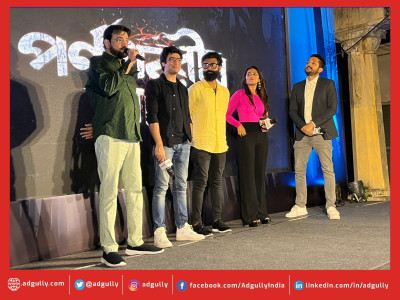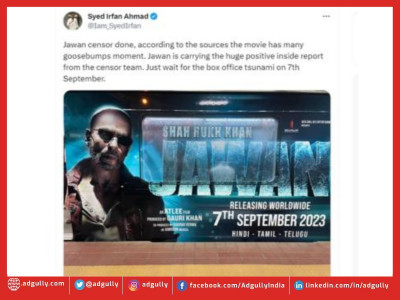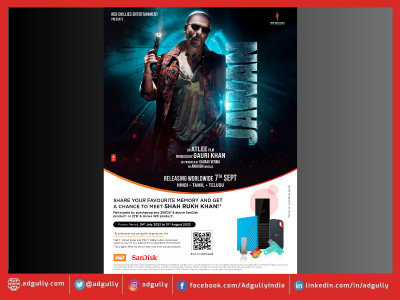Time has come for Indian content to invest in nurturing global audiences: Experts
India is one of the leading creators of films. Indian content has been reaching the vast Diaspora through broadcasters’ tie-ups with cable distributors across nations. OTT has broken down geographical and distribution barriers and has been helping Indian content being sampled by an even growing number of global audiences. However, an occasional ‘Lagaan’ or a ‘Dangal’ notwithstanding, the vast body of Indian content is yet to achieve the status or popularity of content from South Korea or Spain or Latin America across the world.
Read Also: We’ve seen a pattern of news becoming more efficient for advertisers: Experts
There is no dearth of great content from India. So what is keeping Indian content from achieving cult status among a global audience? ‘Making India a Global Content Powerhouse’ was the focus of an exclusive Webinar, held by Adgully on Saturday, July 18, 2020, which had an elite panel comprising producers, distributers, marketers and content creators.
Moderated by Pradeep Dwivedi, CEO - India, Eros International Media Ltd, the panellists included Anindo Banerjee, Head of Originals, Hoichoi; Binda Dey, Head of Marketing, Red Chillies Enertainment; Kranti Gada, COO, Shemaroo Entertainment; and Munnish Puri, Founder & CEO, Rainbox Studios, a part of Rainshine Entertainment.
India has a burgeoning entertainment industry. In terms of annual film output, the Indian film industry is the largest, churning out more than 1,800 movies every year. Millions watch overseas, but account for 12 per cent of revenues for the film industry. The US, which produces 600 films every year, has the highest box office revenues in the world, with 73 per cent gross revenues coming from the international box office.
Eros International’s Pradeep Dwivedi observed, “There is a universality of our stories that has appealed to over 1.4 billion Indians. As time has progressed, some of them have gone all over the world, but continue to be rooted in our culture, history and the type of entertainment content that we make.”
He further added, “We have one of the largest markets in the world, one of the largest broadcasting markets in the world. A vibrant Bollywood and regional language cinema business. A fast growing animation and VFX industry, and all this is fuelled largely by the demand of 1.4 billion people.”
“Considering, that we are roughly one-fourth of the world’s population, and we have no dearth of creative talent, I believe the opportunity for Indian entertainment to grow is 7X. To achieve that, it is important to unlock India’s potential as a global content engine. I rely on our eminent panellists to bring their perspective on how we can grow this market and do it not only aggressively, but profitably,” he pointed out.
Producer of the globally renowned BEING CYRUS, Rainbox Studios’ Munnish Puri opined, “As far as the global content markets are concerned, India has arrived and the numbers too will surely follow. The fact that Amazon recently added $40 billion to its market cap in a single day tells us that the numbers will work for us eventually too.”
He further said, “At Rainshine Entertainment, we believe global markets are looking for Indian content and we’re partnering with content studios and creators to take Indian content to the rest of the world too. Rainshine Entertainment creates content that is format and genre agnostic and in multiple languages. We believe in creating engaging content, but with a sustainable business model, which is where the numbers play a key role too.”
“The Golden Era for Content Creators is here,” declared Puri, adding, “Today, OTT (audio and audio visual) and social media is a huge driver of consumption across the digital landscape. A report by e-marketer found that there are over 3 billion video viewers across the world, and over 50 per cent of these viewers reside in Asia-Pacific region. In India, the global OTT majors, namely, Netflix and Amazon have committed a vast sum of capital and highly effective management teams to create content out of India. In fact, Netflix has announced 17 originals (films and series) a few days ago and intend to invest over INR 3000 crores in India. Reflecting back, India arrived on the world stage, when Guneet Monga brought home an Oscar for the Documentary Film, ‘Period: The End of Sentence’; also Chotta Bheem’s adaptation as ‘Mighty Little Bheem’ on Netflix has garnered a viewership of over 27 million globally.”
He further said, “Amazon and Netflix arrived in India about two to three years ago and their first originals were ‘Inside Edge’ and ‘Sacred Games’ respectively respectively. Today, both these players have grown significantly. Why? Because they have created remarkable content out of India. This reinforces that we highly effective writers, prudent producers, and world class actors in India who are becoming popular globally.”
He believes there is plenty of Indian content with a global appeal. He shares, “Creator Sudeep Sharma and Producer Anushkha Sharma were looking at ‘Pataal Lok’ as an Indian story from its core but has great appeal for global audiences. ‘Special Ops’ by Neeraj Pandey on Hotstar and ‘Kaafir’ by Bhavani Iyer and Sonam Nair on Zee5, are also remarkable shows that have global appeal.”
Puri here said, “We at Rainshine believe that the SCRIPT is now KING. If the content is good, it will have a global appeal and the numbers will follow. Authenticity and reality of the stories will always matter.”
Dwivedi interjected here by saying, “Clearly, one of the factors that will take Indian content global is the way content is created.” He then invited the speakers to discuss how the content creation and aggregation could be streamlined to suit global demand.
Red Chillies Entertainment’s Binda Dey responded by saying, “Red Chillies is known for making movies for the theatre-going audience, but for the last couple of years, we have also been creating original content for OTT platforms. We’ve realized the need for a robust ecosystem with a steady supply of talent. There are 1.4 billion in this country, so there can’t be a dearth of good talent. We need to show that people can make a robust career in this industry and for that, we need to build an ecosystem to draw in; not just of actors, but also writers, directors, cinematographers, music engineers – give the opportunity to young talented people from the length and breadth of the country. Once we have the best talent coming in, only then, can we create the content that will be appreciated globally.”
According to Dey, “Success of ‘Parasite’, ‘Money Heist’ and ‘Fauda’ shows that audiences are open to consuming content from different countries. Content is reaching out to a wide range of audiences via OTT platforms.”
She reflected, “India has a strong USP of genre stories. For example, Indian horror has not been explored to a large extent. Across the world, especially in Hollywood, the focus is on franchised ‘superhero’ content. There is also a market for the kind of stories that we’re good at telling, which is based on relationships, values, and aspirations of people from a bourgeoning economy. These themes are universal, so there is a potential space to reach out to more people with these stories.”
Shemaroo Entertainment stands for content that is unabashedly Indian, posited Kranti Gada. She believed that “When we speak about India’s ambitions to be a content supplier to the world, first, there has to be more demand for our creative product. While the demand is opening up, it is still very niche, and primarily driven by only two platforms (Film and Television). Once there is demand, Indian content needs to invest in nurturing global audiences, especially where there are cultural similarities, for our kind of content to be accepted.”
She observed, “South America, Indonesia, Malaysia have a lot of non-Indian Diaspora viewers. The Indian Diaspora is anyways watching Indian content. We need to nurture the non-Indians in high engagement countries.”
At the same time, she said, “We cannot always cater to global tastes. We should be able to create a demand through our own stories and filmmaking style. In the last 50 years, Bollywood has produced some amazing films and at Shemaroo Entertainment we are figuring out how to create a robust global demand for this content. Outside the Indian Diaspora, only few Indian celebrities are known, like Amitabh Bachchan, Rajnikanth, Shah Rukh Khan, and Aamir Khan. Beyond this, the non-Indian Diaspora don’t know what Indian content is all about.”
Citing some examples, Gada said, “A popular soap in Brazil called ‘Caminho Das Indias’ refers to India, but is shot in Brazil with Brazillian actors. Why don’t we export our TV shows to countries like Indonesia, where Indian serials like ‘Yeh Hai Ashiqui’ and ‘Naagin’ are primetime grabbers? Market development in terms of investing in a market, marketing the content, Stars travelling to various geographies to popularise the content and create demand, that is, an effort to create exposure for Indian content needs to happen.”
She concluded by saying, “We are bigger than Hollywood in terms of films produced, but not in terms of size. To become a true global content supplier, we need to create a demand. There cannot be only some pieces of content going out of India every year which appeal to a global market. If we find audiences with cultural similarities, we will surely find out global audience and be able to better monetise existing content as well.”
“For me, global is anything outside Bengal” claims Hoichoi’s Anindo Banerjee. “Why? While we’re all Indians our culture is very different. We dub our content in Hindi and get the same level of viewership but most of these people don’t know a bit of Bengali.
So, to me, a Hindi speaker watching Bengali content and somebody from Spain watching Bengali content is the same. There might be a difference, culturally, but in terms of language we are the same. We are trying to reach out to anyone outside of Bengal. There is a huge Bengali diaspora, let’s say about 250 million people which is larger than the population in the US. That audience plays into what Kranti said about demand being important. How audiences abroad view us is also very important.
He observes, “In the 60’s, there was a Danish award show called ‘Bodil’ that awarded Satyajit Ray’s ‘Aparajito’ as the Best American Film. For them, only Europe and America existed. Anything, that is not a part of Europe is American. The success of films like ‘Parasite’ shows that International cinema is getting the recognition it deserves. That is probably due to Internet and globalization. This is the right time to connect and reach out to a global audience because there is more exposure now. There were good content creators even back then but we were not able to reach out to the world. Now, we’re in a position to connect with the world and have a lot of stories to tell. At Hoichoi, we always aim to tell stories with a universal appeal.”


















Share
Facebook
YouTube
Tweet
Twitter
LinkedIn